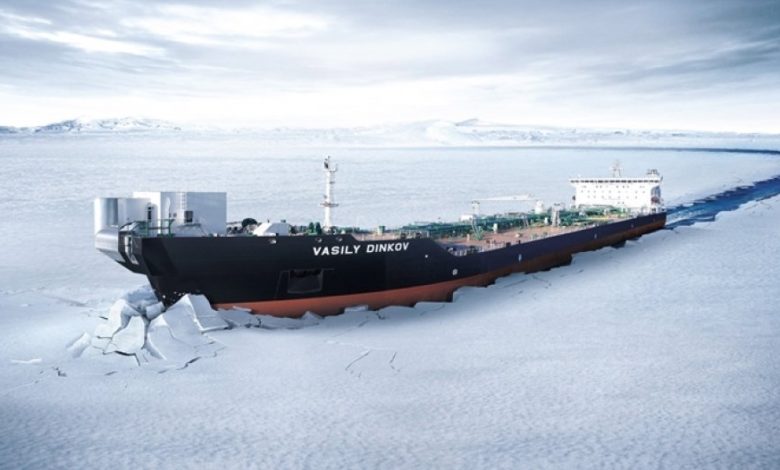Strait talking on heavy fuel oil in the Arctic

Verner Wilson III from Friends of the Earth is in London this week for the Marine Environment Protection Committee (MEPC) meeting at the IMO. The UK capital is a far cry from where Wilson was brought up. A member of the Curyung tribal council, Wilson was born and raised in Dillingham, Alaska and has Yupik family roots in the Bering Strait region between Russia and the US. Below he discusses the possibility of a heavy fuel oil ban in the Arctic.
Every year, hundreds of ships carrying heavy fuel oil (HFO) travel through Arctic waters, posing a huge risk to the marine ecosystems and coastal communities in the area. As someone born and raised in Alaska, I understand that for arctic indigenous peoples, the marine ecosystems and waterways of our area are an integral part of life. They are part of our identity, something that not only sustains us, but helps make us who we are. This April, the Marine Environment Protection Committee of the International Maritime Organization – the UN body that regulates international shipping – will consider a ban on the use and carriage of heavy fuel oil (HFO) by ships operating in the Arctic. The proposed ban is backed by Finland, Germany, Iceland, the Netherlands, New Zealand, Norway, Sweden and the US. I will be in attendance, on the delegation of Friends of the Earth US, a member of the Clean Arctic Alliance, a coalition of 18 non-profit organisations calling for such a ban.
Heavy fuel or residual oil is what’s left at the bottom of the barrel after crude oil is refined. It is a dirty and polluting fossil fuel used to power ships throughout our seas and oceans. Heavy fuel oil (HF) poses risks for both the marine environment and the climate wherever it’s used, but if it spilled in the cold waters of the Arctic, it will break down more slowly than in warmer waters, with long-term devastating effects on both livelihoods and ecosystems.
Around 75% of marine fuel currently carried in the Arctic is HFO. Already, more than half of the HFO carried through the Arctic is by vessels flagged to non-Arctic states – countries that have little if any connection to the Arctic. And as climate change alters the arctic landscape, other countries are increasingly looking to this region for faster global commerce between continents. Melting ice will open Arctic waters even further, allowing larger vessels fuelled by HFO to divert to the Northern Sea Route for faster transportation. This increased traffic will greatly increase the risks of an HFO spill in the Arctic.
This can hurt communities in the Arctic. My mother is from Saint Lawrence Island and my father is from Bristol Bay. St Lawrence Island is just south of the Bering Strait. It’s renowned as a ‘marine mammal superhighway’ for the many migrating whales, walrus, seals, and other species that pass through this area, along with millions of birds and fish. Bristol Bay and the Bering Sea are also host to billion-dollar fisheries. These bountiful marine resources don’t just feed us, they give us a sense of cultural identity. We must ensure they are protected from risks associated with HFO. We’ve already seen how HFO spills can impact communities and the environment. After the Selendang Ayu disaster in 2004, which caused the death of six people, and a spill of 1,200 tonnes of HFO, nearby crab and other fisheries were closed, and beaches were fouled throughout the Aleutian Islands. Clean-up efforts continued for two years; but four years after the spill, oil was still recorded lingering on many beaches.
The intent to change practices and transition to cleaner fuels in the Arctic couldn’t come soon enough. In March 2017, Arctic sea ice hit a new record – the lowest amount of winter ice since satellite records began, 38 years ago. Over the last half century, the total volume of Arctic sea ice in late summer has declined by 75%. The loss is driven by human use of fossil fuels, and greatly increases the potential for an increase in Arctic shipping, which in turn will increase the risks associated with the use of HFO in the region.
The Arctic Council has warned that increased shipping means a higher risk of catastrophic oil spills. Let’s be clear – momentum towards a ban on the use and carriage of HFO as fuel in the Arctic is building. Danish Shipping, Arctic expedition cruise operator Hurtigruten, and Finnish icebreaker operator Arctia are just some of the voices supporting a ban on the use of HFO in the Arctic, while other shipping companies have highlighted the need for regulation of shipping activities in order to maintain a level playing field.
In January 2017, Hurtigruten joined the Clean Arctic Alliance, a group of international non-profit organisations, to launch the Arctic Commitment at the Arctic Frontiers conference in Tromsø, Norway. The Arctic Commitment brings together shipping operators, ports, polar explorers, communities, businesses, and nonprofits – 95 so far – to call for the IMO to phase out the use of HFO, while urging the broader shipping industry to switch to alternative fuels before a ban on HFO is in place.
Arctic IMO member states must not only show leadership by pushing for a ban on HFO – they must persuade fellow member states to seriously consider other ways to power ships. Allowing dangerous heavy fuel oil in Arctic waters can no longer be justified.
